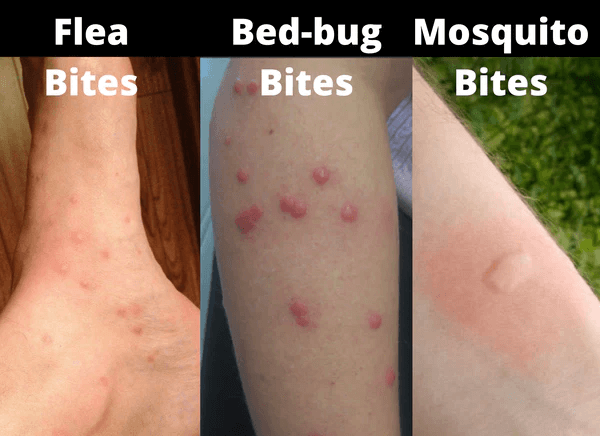You can get bed bugs anywhere. Here’s How to get rid of bed bugs if they come to your house.
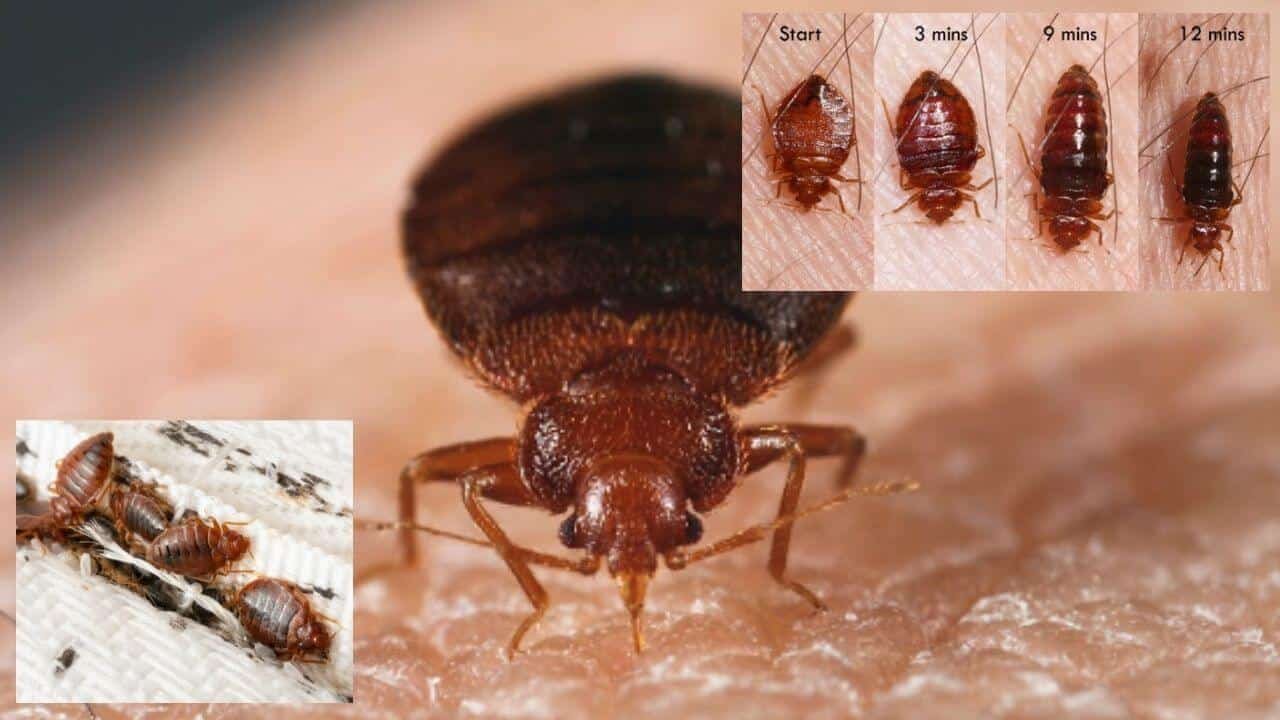
Bedbugs are undoubtedly one of the most dreaded uninvited guests. Your quiet nights could become a nightmare because of these tiny, blood-sucking bugs. Additionally, bedbugs are a global issue, not simply a Parisian one.
This thorough tutorial will explain what bedbugs are, how to spot them, and, most importantly, how to effectively get rid of them. So read on to find out how to safeguard your home and your peace of mind, whether you’re dealing with a bedbug infestation or just want to be ready.
Table of Contents
What Are Bed Bugs?
Small, reddish-brown insects with the scientific name Cimex lectularius, bedbugs consume both human and animal blood. These nocturnal pests spend the day hiding in cracks and crevices before emerging at night to feast.The crawling insects do not generally reside on human bodies and are unable to fly or jump.
The average length of an adult bedbug is five millimeters, or roughly the size of an apple seed.
They have flat bodies that are oval in shape and are typically brown or red in color.The bugs can occasionally take on a more balloon-like look, which may indicate a recent blood feast.
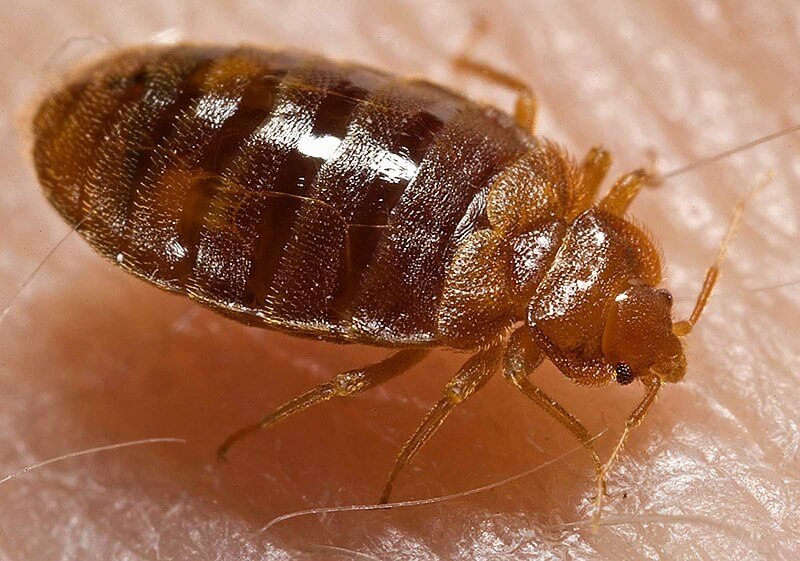
Info
Early in the twenty-first century, bedbug infestations increased everywhere as a result of increased international travel and the bugs’ increasing resistance to pesticides. To prevent infestations, experts advise post-vacation suitcase vacuuming, thorough inspection of used furniture or bedding, and regular checks of common hiding spots like sofas and beds.
Where can you find bedbugs?
During the day, they hide in cracks and holes in walls, floors, and furniture, as well as on beds (mattress seams, box springs, bed frames, and headboards). At night, they come out. They can’t jump or fly, but they can crawl very quickly.
There are bedbugs all over the world, and they are very adaptable. They can infest any place, from opulent hotels to low-cost motels and private residences, but they are frequently associated with overcrowded or temporary living circumstances.
Train seats, headboards, and public building walls can harbor bedbugs. Under armrests, under picture frames, and inside plug outlets, they can attach to commuters’ pants and outerwear.

How can I determine whether I have bedbugs? What symptoms do bedbugs exhibit?
For some individuals, the appearance of itchy spots and rashes on their skin serves as the initial indication of a bedbug encounter. However, experts caution against solely relying on these skin reactions as conclusive evidence of an infestation. This is because many individuals do not exhibit any noticeable response to bedbug bites. While these bites can be irritating to the skin, they typically do not result in additional health concerns, according to reputable sources.
According to these sources, bedbug bites may resemble insect-caused sores. This similarity can complicate the identification and appropriate treatment of an infestation, affording the bedbugs more time to multiply.
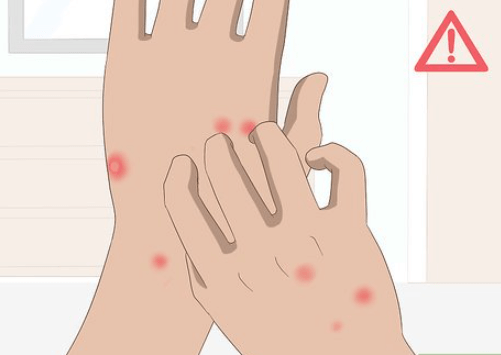
In addition to skin reactions, there are other signs to watch out for, such as fecal matter resembling dark spots. These telltale signs can be found in any area where bedbugs have been, including carpets and mattresses. To effectively detect an infestation, experts recommend examining bedding for stains, eggs, and small eggshells, as well as pale yellow shell casings.
How bed bugs bites look like
Bed bug bites can vary in appearance, but common characteristics include:
- Raised bumps that are set up in random, zigzag, or line designs.
- bumps that look like pimples and have lighter skin around the dark red center.
- There were round bumps filled with clear fluid that looked like boils.
- Some skin is raised and has many small bumps that are usually red or purple and look like hives.

It is important to remember that not everyone will have bite marks that can be seen. Most of the time, these bites look like mosquito or flea bites, with slightly swollen bumps and a dark bruise in the middle that itches.
The likelihood of experiencing a bed bug bite on the upper body is 60% higher than on the lower body. More
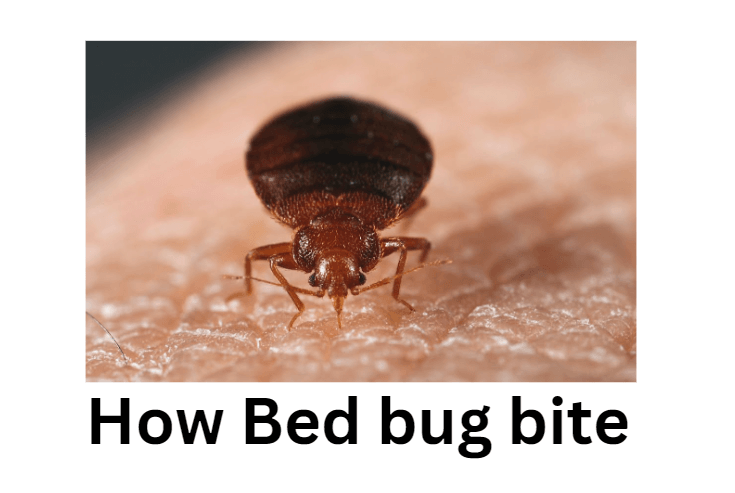
how does bed bugs reproduce

One of the ways that bedbugs reproduce is through a process called traumatic insemination. In this unique way of mating, the male bedbugs use a hypodermic penis to pierce the female’s belly and inject sperm into her mesospermalege, a specific part of her body. The sperm then goes to the seminal conceptacles to be kept. After fertilization, the process takes place in the female’s eggs.

It’s interesting that male bedbugs may sometimes mate traumatically with other males, possibly because they are attracted to each other based on their size. Men, on the other hand, don’t have the protective spermale organ that females do, so this can cause serious damage. To stop this, men can send out alarm pheromones that stop these kinds of attempts. Image Source
The ovary’s growth ends with fertilization, which makes egg production easier in the corpus allatum. Furthermore, females can store sperm in their conceptacles, which keep the sperm at the perfect temperature for long-term storage and allow them to continue laying eggs.
As soon as the female’s conceptacle is empty, she lays several eggs that will not hatch. How many useless eggs she has depends on how well she is fed, but it has nothing to do with how many sperm are available. This complicated way of reproducing sheds light on the fascinating biology of these tiny but amazing bugs.
Fact: Bed bugs are hardy, capable of surviving for months without a blood meal. They can endure extreme temperatures ranging from freezing to 122 degrees Fahrenheit, making professional pest control essential. More Info Here
Bed bugs Life Stages
Bedbugs undergo six primary life stages, comprising five immature nymph stages and culminating in the sexually mature adult stage. These distinct bedbug life stages include:
Bed bugs Life Stages
- Egg (approximately 1 mm in size)
- 1st stage nymph (approximately 1.5 mm in size)
- 2nd stage nymph (approximately 2.0 mm in size)
- 3rd stage nymph (approximately 2.5 mm in size)
- 4th stage nymph (approximately 3.0 mm in size)
- 5th stage nymph (approximately 4.5 mm in size)
- Adult bedbug (approximately 5.0 mm in size)
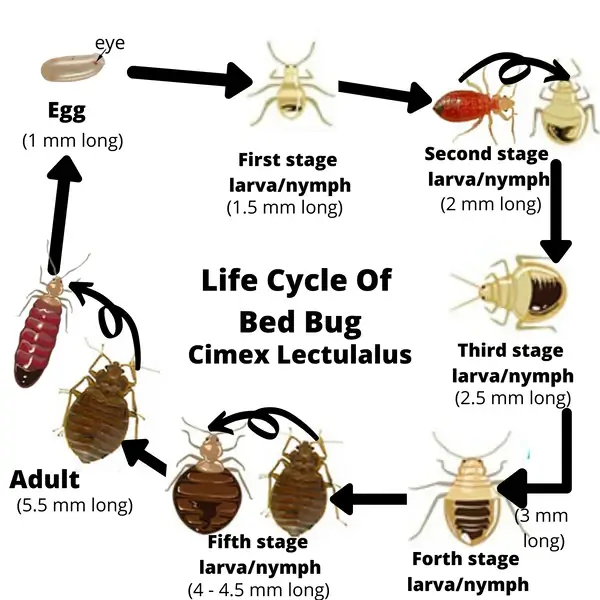
Bedbugs undergo ecdysis, the process by which they shed their outer exoskeleton, at each stage of growth. They must consume at least one blood meal and go through this molting process six times before moving on to the next stage and becoming fertile adults. Each life stage lasts about a week, depending on environmental factors including temperature and food availability.
Once a bedbug attains full maturity as an adult, it gains the capacity to engage in mating and reproduction with another adult bedbug.
From where do bedbugs originate?
The Middle East, where bats and humans coexisted in caves, is where bed bug origins can be traced. This region is also likely to be the source of widespread exposure. Bed insect problems have been a part of human history for thousands of years, with Egyptian, Greek, and Roman civilizations among the earliest to record them.
Bed bugs traveled with humans as their civilizations developed and interacted, infesting both poor and opulent homes in Europe, Asia, and Africa. These pests were further brought to the Americas by European inhabitants. Every continent has now been effectively invaded by bed bugs, proving their flexibility and resilience throughout human history.
You can think of bed bugs as creepy-crawlies. Since they can’t move, they depend on their host to take them from one place to another. This action can happen with moving bags, furniture, or clothes.
As experts emphasize, poor cleanliness is not typically the cause of bedbug infestations. Instead, people usually get sick when they come into contact with these bugs while moving or by touching things that are infested.
Bed bugs don’t like dirt; they like heat, blood, and carbon dioxide. Bed bugs eat birds and animals, and their bites can look like any other bug bite, or they can cause hives or a rash.

During the coronavirus outbreak, people traveled less around the world, which temporarily decreased the number of bedbug cases. But these cases are again becoming more common. It’s interesting that a lot of the people who have asked for help with infestations have recently moved abroad. The Olympics and other events that bring in people from all over the world make it easy for bedbugs to survive and spread.
How bedbugs get into a place
- Bedbugs are good at traveling because they can stick to luggage, shoes, and other belongings. Hotels and other places with a lot of guests are common places where bedbugs get into.
- Used Furniture: Bedbugs or their eggs may be hiding in used furniture that you don’t know about, which can be dangerous when brought into your home. Check things carefully before bringing them in.
- In public places like schools, colleges, companies, and other places where people hang out, clothes and other fabrics can be used to spread bedbugs. When people come home, the bugs are already inside.
How to get rid of bed bugs
Getting rid of bedbugs is hard and can take weeks or months. Depending on how bad the problem is, you may need professional help. Success factors include the number of infested areas, the number of hiding places available, the number of infested neighbors, and the number of people who live or work in a building or house.
How to Get Rid of Bedbugs
Some steps that work are washing clothes and blankets that are infested, using high-heat dryers, dry cleaning, and steam cleaning. Things that are infested can be put in plastic bags and sealed until they are treated. Things that have already been treated should also be sealed for up to a year.

Diagnostics says that it is hard to get rid of insects that are resistant to insecticides. If you try to get rid of the bugs yourself, they might spread, and hiring a professional can be pricey. Experts say that not all infections are that bad and that professional help may not always require a lot of work.
Additional Tips to Get Rid of Bed Bugs
If you are patient and work hard, you can get rid of bedbugs on your own. Do these things:
Step 1: Identify Infested Areas
- Search for bedbugs in seams, cracks, and furniture.
- Use a flashlight and magnifying glass.
- Look for live bedbugs, droppings, stains, eggs, and shells.
- Collect a sample for identification.
Step 2: Contain the Infestation
- Vacuum infested areas, seal the vacuumed contents in plastic bags, and dispose of them.
- Seal linens and clothes in plastic bags for washing and drying.
- Bag items that can’t be washed and leave them sealed for several months.
- Discard infested furniture, marking it as “bedbugs.”

Step 3: Prepare for Bedbug Treatment
- Clean and remove clutter from affected areas.
- Seal open areas like cracks and outlets.
- Move the bed away from the wall.
- Use mattress encasements or bed bug-proof covers for added protection.
Step 4: Kill the Bedbugs
- Use high heat (above 115°F) to wash and dry bedding and clothes.
- Steam mattresses and furniture.
- Freeze sealed bags containing bedbugs.
- Consider EPA-registered insecticides if needed.
Step 5: Evaluate and Prevent Future Bedbugs
- Check infested areas for activity every 7 days.
- Use bedbug interceptors under bed legs.
- Be prepared to try different treatments if needed.
Step 6: Get Professional Help
- If DIY efforts fail, hire a professional exterminator.
- Professionals have access to specialized treatments and equipment.
Step 7: Prevent Reinfestation
- Clear clutter and avoid leaving items on the floor.
- Use bedbug covers for mattresses and box springs.
- Regularly vacuum and wash bedding, furniture, curtains, and carpets.
- Seal cracks to prevent bedbugs from entering.
- Inspect hotel rooms during travel to avoid bringing bedbugs home.
How to keep bed bugs away while traveling
It’s important to stay away from bedbugs when you travel, and there are steps you can take to lower the risk. Most of the time, bedbugs don’t get into planes, trains, or cars, but they can get on luggage and personal things. To keep yourself safe:
- Pack clothes inside your bags for short stays, and make sure they stay closed when not in use.
- Seek out dark spots, live bugs, or shed skins that look like bedbugs in your hotel room. Pay special attention to the seams of the mattress and the folds of the furniture.
- Use luggage racks to raise your bags so they don’t touch the beds or rugs.
- When you get back, check your bags and clothes carefully and vacuum them. To get rid of any possible bedbugs, wash and dry your clothes on high heat.
If you take these steps, you can lower the chances of getting bedbugs while traveling and keep them from coming into your home.
How to Determine Whether You Have Fleas or Bed Bugs
Distinguishing between flea and bedbug infestations can be challenging due to their similarities, but understanding specific differences is crucial for effective control.
While both pests are reddish-brown and easily apparent, bed bugs have flat, oval-shaped bodies, whereas fleas have long, flattened bodies.
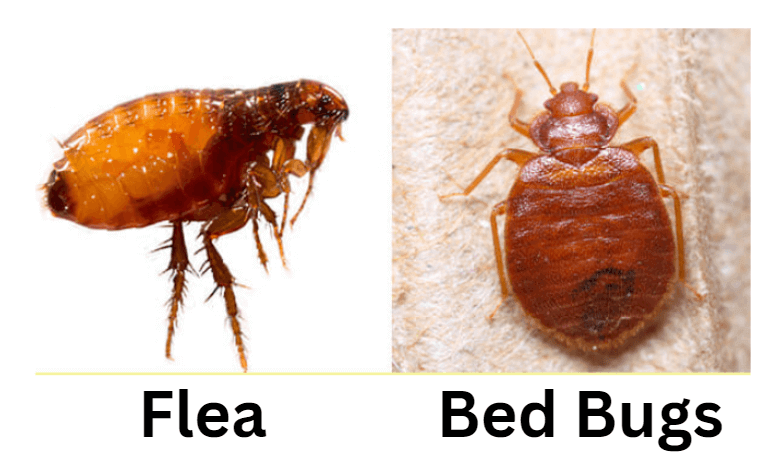
In contrast to fleas, which prefer to bite cats or dogs but will occasionally attack humans as well, bed bugs prefer humans and rarely harm animals.
Bed bugs can only move slowly and cannot fly or jump, whereas fleas have strong legs and can cover huge distances.
Both pests are difficult to get rid of since they reside inside or close to their hosts. Mattress cleaning and pet hygiene can lower populations, but they won’t get rid of the infestation. Hire professionals like Orkin for accurate identification and removal.
Bite Location: Flea bites tend to appear on the lower body, like legs, ankles, and feet, as fleas jump from the ground or pets. Bedbug bites are more likely on the upper body, including the face, neck, arms, and upper torso, targeting areas touching bedding during sleep.
Bite Pattern: Flea bites may cluster or form a line of small, red, itchy bumps resembling tiny dots. Bedbug bites often cluster but present as raised, red welts with a darker center.
Bite Pattern: Flea bites may cluster or form a line of small, red, itchy bumps resembling tiny dots. Bedbug bites often cluster but present as raised, red welts with a darker center.
Itchiness: Flea bites are known for intense, nearly immediate itching. Bedbug bites may itch but vary in severity.
Time of Day: Fleas are active during the day, leading to bites noticed throughout the day. Bedbugs are mainly nocturnal, with bites typically discovered in the morning or upon waking.
Location of Infestation: Fleas are commonly linked to pet-infested homes, often in carpeted areas. Bedbugs are typically found in sleeping areas, like mattresses, box springs, and bed frames.
bed bugs Frequently Asked Questions
What are bed bugs?
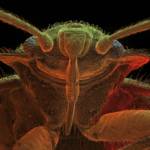
Bed bugs (Cimex lectularius) are small, reddish-brown parasitic insects that feed on the blood of people and animals while they sleep. They are approximately 1mm to 7mm in size and can survive for months without a blood meal.
Where are bed bugs found?

Bed bugs are globally distributed and have been increasingly found in developed countries. They are commonly found in areas where people sleep, including apartments, hotels, dorms, and transportation vehicles. They hide during the day in cracks, crevices, and seams of furniture, mattresses, and other objects.
What health risks do bed bugs pose?

Bed bug bites vary from no physical signs to small bite marks or allergic reactions. An allergic response may require medical attention, but bed bugs are not considered dangerous.
How am I supposed to know if a bed bug has bitten me?

Bed bug bites are often painless initially due to anesthetics in their saliva. Itchiness and redness develop later. Bite marks may appear in a straight line or randomly, and some individuals may not react to bites at all.
How are bed bugs treated and prevented?

Bed bug bites can be treated with antiseptics, lotions, and antihistamines to alleviate itching. Infestations are typically treated with insecticide sprays, and professional pest control may be needed. Prevention involves regular inspection for signs of infestations.
Who is at risk of getting bed bugs?

Anyone visiting an infested area is at risk. Frequent travelers who share sleeping quarters with others have a higher risk of encountering and spreading bed bugs. Source
what kills bed bugs instantly

At 122°F (50°C), bed bugs and their eggs perish. Bed bugs are instantly killed by the steam’s 212°F (100°C) high temperature. This is the best way How to get rid of bed bugs.
The efficiency of various strategies for eradicating bed bug infestations varies. Due to its flammability, rubbing alcohol kills up to 50% of bed bugs instantly but doesn’t get rid of eggs or nymphs. When applied on afflicted materials and dried in high heat, bleach is an efficient instant bed bug killer. Bed bugs may be deterred by essential oils, but they might not completely eradicate them.
Other techniques include the use of chemical insecticides, disinfectants, baking soda, vinegar, high temperatures, diatomaceous earth, dry cleaning, boric acid, salt, and hydrogen peroxide. However, they might not ensure total eradication or carry hazards like toxicity. The best course of action for a major infestation is frequently to hire a professional exterminator, as they have access to effective techniques that may eliminate all bed bugs, including nymphs and eggs. Source
Bed Bugs Paris
There are several causes for the high occurrence of bed bugs in Paris. With 44 million visitors expected in 2022, Paris will be the most visited city in the world. As a result of this constant flood of tourists, bed bugs are able to proliferate quickly. Additionally, according to ANSES, the French health and safety organization, bed bug infestations have increased in frequency in France, with over 10% of homes reporting infestations between 2017 and 2022.
The surge in travel is a key factor in the increase in bed bug infestations. Bed bugs have more opportunities to travel in luggage and clothing as more people travel to and from Paris, which increases the number of bed bugs in the city. Additionally, these bed bugs have evolved a resistance to widely-used insecticides, turning them into superbugs. It is now considerably more difficult to stop their spread in Paris and other impacted places since they have evolved to resist and adapt to the poisons commonly employed to destroy them.
Conclusion
Although bedbugs may not care where they live, you can protect your house from these persistent pests if you have the correct knowledge and take a proactive approach. Keep in mind to take quick action if you detect an infestation, and don’t be afraid to call in experts if necessary. You can keep bedbugs out of your home and resume having restful nights by remaining knowledgeable and organized.

